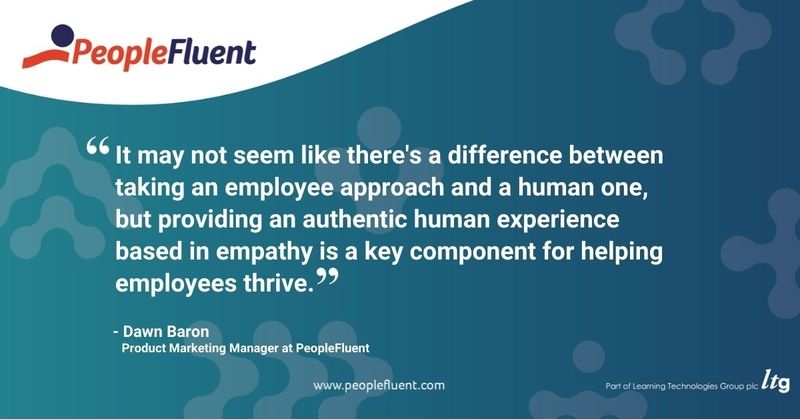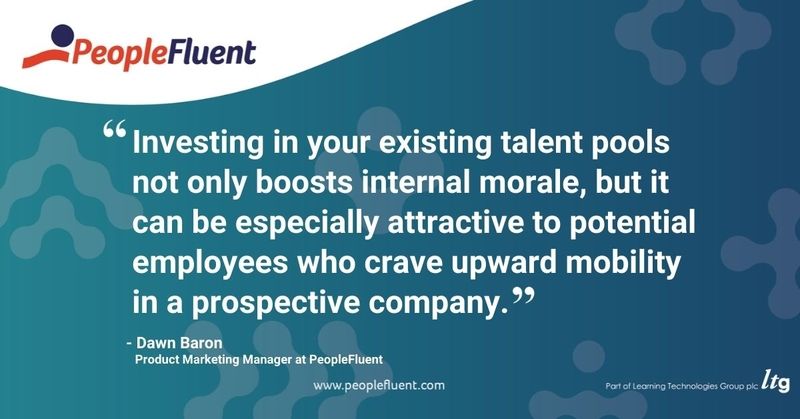Published: Apr 15, 2020Time to read: 7mins Category: Insights
How to Operationalize Reskilling Efforts with a Human Approach
Now more than ever, we are experiencing, first-hand, an unprecedented and substantial shift in how our workforces operate. When the white paper, ‘A Human Framework for Reskilling: How 5 Seismic Forces are Driving the Reinvention of Learning & Talent’, was originally published earlier this year, none of us realized how timely it truly was. In this article, we provide insights from a recent webinar, ‘How to Bring Your Reskilling to Life’ with advice on how businesses can take advantage of the proper tools to do so.
In his foreword to the white paper, Stephen Bruce, PeopleFluent’s Managing Director, said “the one constant is that organizations are characterized by change.” Considering recent circumstances related to the COVID-19 pandemic, this is especially true. And, it means that a company’s reskilling efforts are even more critical to their overall success.
Throughout this article, we’ll address the pressing questions we received from business leaders during our recent reskilling webinar and provide insights on how the current shift in our workforces will have a lasting impact on the way we work.
The Difference Between an ‘Employee Approach’ and a ‘Human Approach’
During the webinar, one of our attendees asked an important question that can help HR leaders better understand the difference between taking an employee and a human approach. The following can ensure the approach you take will deliver the best possible experience for your people:
Can you expand on the difference between ‘employee’ experience and ‘human’ experience?
It may not seem like there’s a difference aside from semantics. Your employees are human, after all. However, the employee experience leans more toward the benefits and environment that an employer providers for employees. Providing a human experience is to know how to treat others with empathy—a key component in helping employees thrive, according to Mercer’s 2020 Global Talent Trend Study.
Today, it’s critical for HR teams and managers to have a deep understanding of how many directions people are being pulled in. Employees, much like many adults, are expected to maintain productivity at work while also keeping up with personal and family expectations. When you throw in a global pandemic that causes an immediate shift in the way we all work, it’s almost impossible to ensure your workforce remains productive unless changes are made.
For instance, employers typically don’t question employees about childcare, unless it affects their ability to consistently produce results. Now, employers are well aware that parents do not have their usual childcare options. Rather than penalizing these employees, many businesses have offered flexible hours for their parent populations or others with extenuating circumstances. What’s more, some employers have even encouraged employees to have their children “join” a video call for a quick chat with a co-worker’s child. Small gestures like this make your employees feel valued on a human level.
For the first time in a long time, we’re all heavily in tune with how others feel as we all face the same circumstances. When we come out the other side of this, we’ll need to keep that perspective and keep that human approach. It’s important to understand that a crisis may affect certain populations or individuals within our organizations at any time and it’s our human responsibility to be supportive.

Related content: 'Retooling Talent Management: How HR Teams Can Engineer a New Era of Productivity'
Embracing the Cultural Shift
Another attendee raised the question of how organizations can ensure collaboration within their teams by overcoming the new skill gaps associated with a shift to fully-remote work.
In the multigenerational environment of today's workforce, what would you suggest to get the team on the same page when it comes to embracing the electronic platform/culture shift? The gap is wide in many businesses.
According to a recent survey, 80% of CEOs believe their biggest challenge is reskilling. With the increased complexities of work and shrinking talent pools due to demographic shifts, HR teams and business leaders must find a way to ensure employees adopt the necessary skills while embracing a workplace’s cultural shift. For many businesses, skill gaps continue to widen and asking employees to learn in the flow of work may not be possible without proper tools—especially when the flow of work is so fluid. Getting your teams on the same page and making it easier to use digital platforms for learning is a key part of solving the challenge.
Before the pandemic, digital learning tools were just one of many channels that helped cater to varied learner preferences. While one professional may prefer written instruction, another may prefer to learn by watching a video. Now, video communication and learning has become the norm. As the old adage goes, "Necessity is the mother of invention" and the same philosophy can now be applied to your workforces. In order to communicate and access learning content, employee populations that may not have previously chosen to utilize video for learning and/or communication now find it necessary to do so during extended periods of working from home.
These experiences are paving way for a multigenerational exploration and acceptance of digital tools with a heavy focus on video. Of course, video should be considered in a company’s long-term strategy but L&D professionals should also be encouraged to incorporate visual, written, and auditory learning content. Digital platforms are a wonderful tool for managing all preferences as of now, but they should be balanced with in-person interaction once it is an option again.
More from the blog: ‘4 Tips for Organizations Using Technology to Train Staff Now Working From Home'
How Reskilling Translates to a Higher ROI
Our next query was more of a statement, but it does call attention to a dilemma many organizations may have faced before and during the quick transition from in-office working to fully-remote: how to ensure a return on investment during times of vast uncertainty.
This may be a new and unplanned cost for businesses: to transition from a face-to-face workplace to a remote workplace in such a short period of time.
It’s understandable that companies must still hold onto a semblance of “business as usual” however they can. While new and unplanned costs for businesses have risen due to the shift from in-office to remote workplaces, many organizations already employed a percentage of digital workers. Contingent workers, such as freelancers and/or contract employees as well as full-time remote workers, have existed for years. With a fully-remote workforce, the transition has been accelerated and processes must be implemented to facilitate such a change.

This begs the question: Are we focused too much on reskilling our individual workforces rather than reskilling our organizations as a whole? That is to say, perhaps the real investment business leaders and executives need to make is not in their individual employees’ skill sets, but in their organizations as a whole. Business leaders should focus on their ability to provide digital learning tools which embolden their employees to embrace such shifts. An investment must be made to ensure companies have a plan that will serve as more than just a band-aid approach and include a plan for the long-term possibility of having a completely remote workforce.
On the individual level of reskilling, it’s important to remember that within the next few decades, workforces will be bidding adieu to an entire generation of workers: baby boomers. As they head towards retirement, this generation will take a wealth of knowledge with them, leaving senior leadership roles ready to be filled. Astute HR teams should deploy the aforementioned long-term strategy in order to ensure these shoes are properly filled. For more, read ‘6 Foundations for Effective Succession Planning’.
Investing in your existing talent pools not only boosts internal morale, but it can be especially attractive to potential employees who crave upward mobility in a prospective company.
Discover Why Organizations are Prioritizing Their Reskilling Efforts
Interested in learning more about how you can join the race for reskilling in your organization?